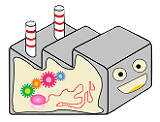Gifu/official team profile
From 2014.igem.org
(Difference between revisions)
| (One intermediate revision not shown) | |||
| Line 59: | Line 59: | ||
<tbody><tr><td style="padding: 5px 0px; width: 750px; font-size: 10pt; font-weight: bold;" colspan="9">Circular mRNA - the world's longest protein<br> | <tbody><tr><td style="padding: 5px 0px; width: 750px; font-size: 10pt; font-weight: bold;" colspan="9">Circular mRNA - the world's longest protein<br> | ||
| - | <tr><td style="padding: 5px 0px 5px 20px; width: 750px; vertical-align: top;" colspan="9"> Generally, mRNA is single-strand RNA, starting translation by binding ribosome on initiation codon, and ending by separating ribosome from mRNA. In this study, we aim to build the method of synthesizing long-repeating proteins, massive one, and to improve translation efficiency. That is, allowing ribosomes to have a semi-permanent translation mechanism by producing circular mRNA and causing a defect of termination codon. To cyclize mRNA, we can use a splicing mechanism of T4 phage. Splicing is a mechanism removing circular introns and joining in exons after transcription. Splicing is catalyzed by several base sequences at both ends of intron as a ribozyme, being subjected to nucleophilic attack from introns to exons. We would like to clone the two parts of intron to use this mechanism and cyclize mRNA, making plasmids which include a gene coding proteins between those. And, by transforming E.coli, we get world’s longest proteins. | + | <tr><td style="padding: 5px 0px 5px 20px; width: 750px; vertical-align: top;" colspan="9"> Generally, mRNA is single-strand RNA, starting translation by binding ribosome on initiation codon, and ending by separating ribosome from mRNA. In this study, we aim to build the method of synthesizing long-repeating proteins, massive one, and to improve translation efficiency. That is, allowing ribosomes to have a semi-permanent translation mechanism by producing circular mRNA and causing a defect of termination codon. To cyclize mRNA, we can use a splicing mechanism of T4 phage. Splicing is a mechanism removing circular introns and joining in exons after transcription. Splicing is catalyzed by several base sequences at both ends of intron as a ribozyme, being subjected to nucleophilic attack from introns to exons. We would like to clone the two parts of intron to use this mechanism and cyclize mRNA, making plasmids which include a gene coding proteins between those. And, by transforming <i>E.coli</i>, we get world’s longest proteins. |
</tr></tbody></table><br> | </tr></tbody></table><br> | ||
<style> | <style> | ||
| Line 164: | Line 164: | ||
</div> | </div> | ||
</div> | </div> | ||
| + | <br> | ||
</body> | </body> | ||
</html> | </html> | ||
Latest revision as of 00:49, 18 October 2014




Official Team Profile
iGEM 2014 Team Information
From 2014.igem.org
| Team Name: | Gifu | ||||||||
| Primary Contact (PI): | Akio Ebihara | ||||||||
| Schools: | Gifu University Yanagido, Gifu, Japan | ||||||||
| Division: | iGEM | Application Date: 2014-02-17 | |||||||
| Section: | Undergraduate | ||||||||
| Region: | Asia | Acceptance Date: 2014-04-23 12:49:42 | |||||||
| Description: | |||||||||
| Team Status |
| Welcome to iGEM 2014 ! Your iGEM 2014 team application was accepted by iGEM Headquarters on 2014-04-23 12:49:42 and your team registration fee has been received. |
 DNA Kit of Parts shipping information has been entered, thanks.
View shipping information DNA Kit of Parts shipping information has been entered, thanks.
View shipping information |
 Resource description has been submitted, thanks.
View resource description Resource description has been submitted, thanks.
View resource description |
 Your registration fee has been received. Thank you.
More... Your registration fee has been received. Thank you.
More... |
| TrackMore... |
| Assigned Track: New Application |
| Title and AbstractMore... | Download a .pdf version |
| Circular mRNA - the world's longest protein | ||||||||
| Generally, mRNA is single-strand RNA, starting translation by binding ribosome on initiation codon, and ending by separating ribosome from mRNA. In this study, we aim to build the method of synthesizing long-repeating proteins, massive one, and to improve translation efficiency. That is, allowing ribosomes to have a semi-permanent translation mechanism by producing circular mRNA and causing a defect of termination codon. To cyclize mRNA, we can use a splicing mechanism of T4 phage. Splicing is a mechanism removing circular introns and joining in exons after transcription. Splicing is catalyzed by several base sequences at both ends of intron as a ribozyme, being subjected to nucleophilic attack from introns to exons. We would like to clone the two parts of intron to use this mechanism and cyclize mRNA, making plasmids which include a gene coding proteins between those. And, by transforming E.coli, we get world’s longest proteins. |
| Team Roster |
| Instructors | |||
| aebihara2014 | Akio Ebihara | ||
| isatoshi | Satoshi IWAMOTO | ||
| h1884 | Hitoshi IWAHASHI |
| Student Members | |||
| ybanno | Yusuke Banno | ||
| nomuken | Nomura Kenta | ||
| momochi | Momoko YAMADA | ||
| kozakai | Kozakai Tomoya | ||
| Mori | Akihiro Moriyama | ||
| Yuki1201 | Yuki Kamijo | ||
| SachiA | Sachi Asano | ||
| takema | Hasegawa Takema | ||
| fukufuku | Wataru Fukuda | ||
| Lagomutry | Ouchi Ryo | ||
| uyuu | Endo Yuki |
| This range of part numbers has been assigned to your team for use during the summer: BBa_K1332000 to BBa_K1332999 |
 "
"